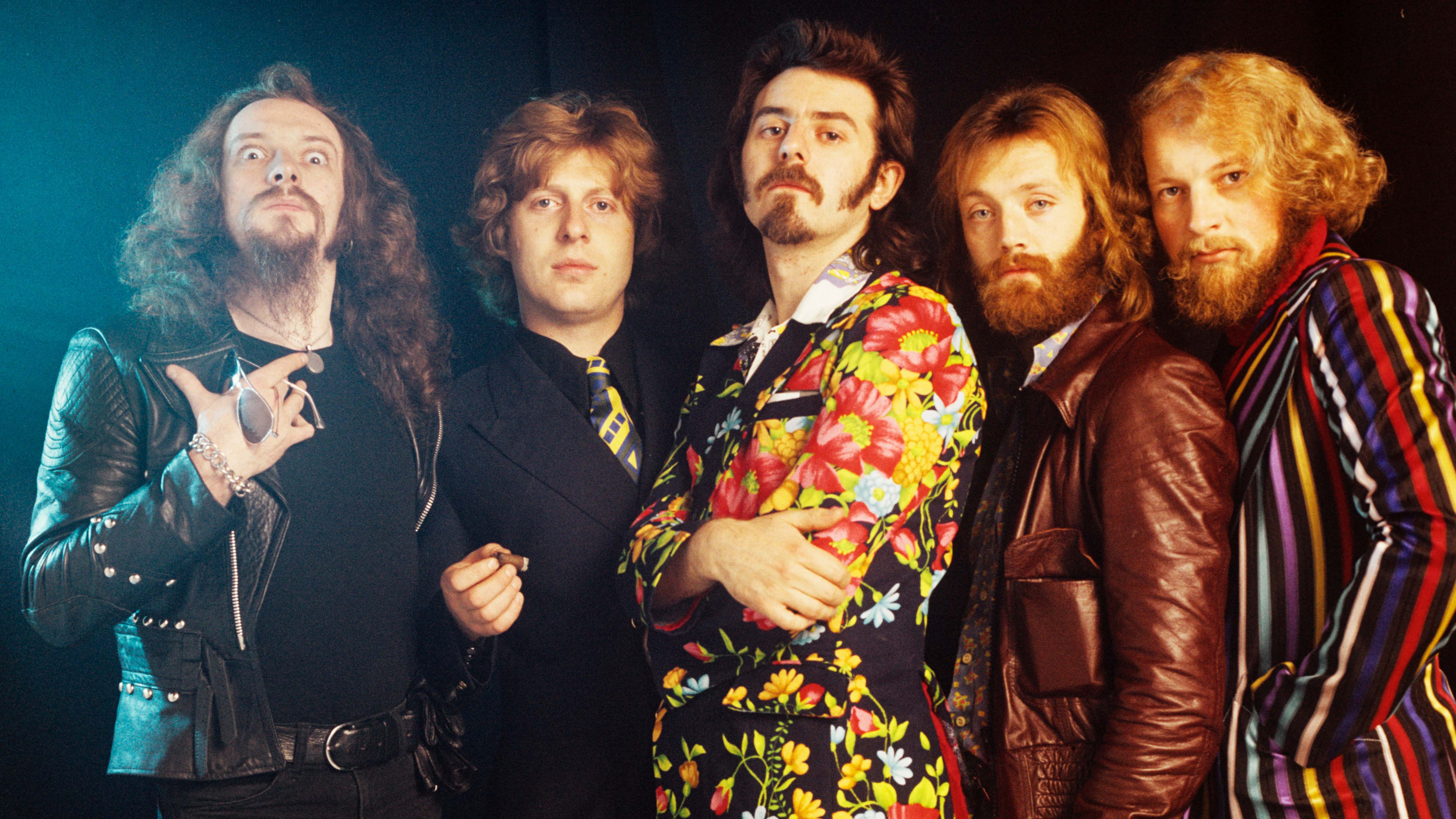5 essential Jethro Tull songs guitar players need to hear
"And here was Jimmy Page waving like mad… I'm thinking, 'I can't wave back, or I'm going to blow the solo'”

Few bands of the early '70s created such a defiantly idiosyncratic sound as Jethro Tull. Formed in Luton in 1967 and named after an 18th century farmer/inventor, the band emerged from the late 60s British blues boom and forged a dense sonic mix which incorporated heavy rock, flute-led folk melodies, blues infused licks and surreal lyrical imagery.
Led by enigmatic frontman Ian Anderson, the band attained massive critical and commercial success in the early 1970s with albums such as Aqualung (1971) Thick As A Brick (1972) and A Passion Play (1973).
The band started life as the Blades, an outfit formed in Blackpool, where the family of Edinburgh-born Anderson had moved in 1960. By 1967 they had moved south to Bedfordshire and in December that year Jethro Tull were formed.
In 1968, they released debut album This Was, opened for Pink Floyd at the first free rock festival in Hyde Park and appeared on the Rolling Stones’ Rock & Roll Circus, with Tony Iommi on guitar. He had replaced guitarist Mick Abrahams but the Black Sabbath founder lasted only a week before leaving and being replaced by Martin Barre.
In May 1969, after touring with Hendrix and Led Zeppelin, they scored a No. 3 hit with the song Living In The Past. What set Tull apart was Anderson’s flute playing, a unique yet divisive instrument among the late '60s blues purists.
Their folk-tinged second album Stand Up topped the UK charts and reached No. 20 in the US, catapulting them from the margins to the mainstream and opening up touring opportunities in the UK and US. By then Anderson had developed a charismatic and eccentric onstage presence, with his wild hair, frock coat and tights, enhanced by an expression of mad-eyed delirium.
But it was their fourth album Aqualung that would become their magnum opus. Released in March 1971, the album heralded a whole new sonic template for the band, introducing progressive rock themes while fusing strident hard rock passages with more ethereal folk. By then, the line-up behind Anderson was Martin Barre (guitar), John Evan (keyboards), Jeffrey Hammond (bass) and Clive Bunker (drums).
Get the MusicRadar Newsletter
Want all the hottest music and gear news, reviews, deals, features and more, direct to your inbox? Sign up here.
On Aqualung chief songwriter Anderson found his lyrical voice, introducing themes that were more serious and intellectual. The album was inspired by old photos of homeless people on the Thames Embankment. The core lyrical themes of religion and alienation chimed with listeners in the UK and in the US. The album went on to sell seven million units worldwide.
The band’s fifth Thick As A Brick followed in 1972, a ‘parody’ concept album featuring just one 43-minute track, and in 1973, A Passion Play was another creative high watermark.
On Songs From The Wood (1977) the band shifted towards folk-prog, inspired by Anderson’s move to rural Buckinghamshire. Over the following decades they continued to stretch themselves creatively – the hard rock of 1987’s Crest Of A Knave being one of the high points, but it is arguably their 70s output, most noticeably Aqualung, Thick As A Brick and A Passion Play, that yielded their most enduring sonic riches.
1. Aqualung – Aqualung (1971)
If one song defines everything that made Jethro Tull unique, this is it. It’s a song regarded by many as their masterpiece, the title track of an album inspired by old photos of homeless people on London’s Thames Embankment. Imagined stories of these transient characters from society’s margins inspired a rich vein of songwriting in Anderson.
Lyrically, it’s both literal and melodramatic. ‘Snot's running down his nose / Greasy fingers, smearing shabby clothes… Feeling like a dead duck / Spitting out pieces of his broken luck.”
The track meanders between hard and soft passages but is anchored by a staggered, overdriven guitar riff, written by Anderson on an acoustic and then shown to guitarist Martin Barre.
"I wrote the main riff in a hotel room in New York City,” Anderson told Guitar World magazine in 2013. “At the time I was trying to write songs that had [single-note] lines that would translate on the electric.”
Barre’s choice of gear on this album was heavily influenced by Leslie West of Mountain, who Tull had toured with in the US. “I thought his tone was tremendous, so I bought a Les Paul Junior,” Barre told Vintage Guitar magazine in October 1997. “That was the only guitar I used on the Aqualung album. I didn’t use any effects; I plugged straight into the Hiwatt. The reverb or any other sounds were studio rack effects.”
In a 2015 interview with Classic Rock, Barre recalled recording the solo to this song, when Jimmy Page walked into the studio.
“He walked into the control room to say hello, just as I was recording the solo to Aqualung. Now, in those days, if you didn't get a guitar solo in one or two takes, it might become a flute solo. It was, 'Go in there and do it or else'. And here was Jimmy waving like mad – 'Hey, Martin!' – and I'm thinking, 'I can't wave back, or I'm going to blow the solo'.
2. Thick As A Brick (Side 1) – Thick As A Brick (1971)
Ian Anderson was not happy with critics hailing Aqualung as a concept album and so allegedly conceived Thick As A Brick as a parody of a concept album. The original packaging was designed as a 12-page newspaper, with Anderson using surreal Monty Python-style humour to poke fun at the band, the fans and the music critics. As he described it, the plan was to "come up with something that really is the mother of all concept albums".
The album has just one long track, split over two sides. In some ways, the plan backfired, because what Anderson came up with, certainly across the hugely engaging 22 minutes 39 seconds of side one, is a flawless slice of progressive rock. Or as Classic Rock put it “such a brilliant piece of music that it stands almost in a category all by itself”.
Apart from drummer Clive Bunker, who left and was replaced by Barriemore Barlow, this is the same line-up as Aqualung, and the playing is exemplary – adventurous, assured and nimble.
English folk influences pervade across this piece, interspersed with full-on breakneck prog – complex stabs, time signatures, arpeggios and phrasings with organ, bass and flute in particular providing soaring, virtuoso performances. Lyrically, the whole work hinges on the notion that an eight-year-old boy, the fictitious Gerald Bostock, had written all the lyrics for the album.
“I have to admit that I really imposed the whole idea on the other guys,” Anderson told Classic Rock. “But, for whatever reason they went along with it, and actually warmed to the task once we got stuck into the music.”
3. Locomotive Breath – Aqualung (1971)
Another masterpiece from the Aqualung album and a track which has served as the band’s encore since 1972. “Despite the title, it’s actually about the problems of population explosion and the demands society puts on us as a consequence,” recalled Anderson in 2020. "We’re on a train heading in the future, whatever that might lead, and we cannot get off. The song is meant to be a bit scary and threatening.
“I keep being drawn back to the subject [of trains], because public transport is part of my life. I don’t drive, so rely on buses, trains and the like. But here it is about a serious social issue.”
The track intros with John Evans’ bluesy piano, before lurching into bombastic hard rock. “In the shuffling madness,” begins Anderson, “Of the locomotive breath / Runs the all-time loser / Headlong to his death”.
Unusually for the time, the song was pieced together from overdubs, because as Anderson put it “Locomotive Breath was actually an utter failure when we tried to play it all together. It didn't gel. We didn't get the groove.”
4. Songs From The Wood – Songs From The Wood (1977)
Jethro Tull fans were dealt a stylistic curveball on their tenth album, Songs From The Wood, which veered away from the dense prog leanings and immersed itself in pastoral folk-rock with tinges of classical. This title track opens with close vocal harmonies and Anderson’s vocal timbre fits seamlessly within the folkier style.
The prog time signatures and complex stops and starts are still there but the hard rock is absent and there’s a warm grandeur. By 1977, Anderson had bought a farm estate in rural Buckinghamshire, which prompted his pursuit of a folkier, more organic sound.
Lyrically, the album was filled with medieval imagery and there’s a poetic feel throughout. “Let me bring you all things refined / Galliards and lute songs served in chilling ale / Greeting well-met fellow, hail / I am the wind to fill your sail.”
5. A New Day Yesterday – Stand Up (1969)
Guitarist Martin Barre replaced founding member Mick Abrahams on Tull’s second album and it’s the former’s explosive riffing that dominates this opening track. It’s a stunning piece of music, blending classical, blues, jazz, and psychedelia into a strident, new ‘progressive’ rock sound.
The production is spacious, with fluid bass and big ambient drums. Raunchy harmonica reflects the band’s blues roots and Barre’s powerful stabs and squalls weave within the whole. At its core, this is heavy blues, primitive and compelling. At 1:47, Barre lurches into a growling solo before Anderson picks it up on Hammond organ and flute at 2:10.
Opinions differ on what guitar Barre used on the Stand Up album. As he explained to Guitarist magazine, he used a Gibson 330 for his first audition, and due to feedback issues with the hollow body he bought Gibson SG Special for the next year before he bought the Les Paul Junior.

He complimented his sound with one particular effect. “In the very early days, I used Hiwatt and they didn’t drive very readily and so I had this horrible treble booster," Barre told Guitarist in 2015. "It pushed things at the front end but unfortunately, it was very, very prone to picking up radio stations, particularly in America. It was a nightmare. Sometimes the radio signal was louder than the guitar!
“When I started using Marshall amps, I found that I could ditch the treble boosters but I think it put me off for life, really. I thought all those things are more trouble than they’re worth."

Neil Crossley is a freelance writer and editor whose work has appeared in publications such as The Guardian, The Times, The Independent and the FT. Neil is also a singer-songwriter, fronts the band Furlined and was a member of International Blue, a ‘pop croon collaboration’ produced by Tony Visconti.
“Every note counts and fits perfectly”: Kirk Hammett names his best Metallica solo – and no, it’s not One or Master Of Puppets
“I can write anything... Just tell me what you want. You want death metal in C? Okay, here it is. A little country and western? Reggae, blues, whatever”: Yngwie Malmsteen on classical epiphanies, modern art and why he embraces the cliff edge









